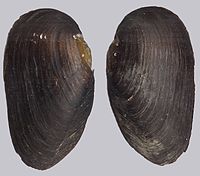
Photo from wikipedia
Consumers contribute to nutrient cycling in aquatic ecosystems by nutrient retention in tissues, metabolic transformations and excretion, and promoting microbial processes that remove nutrients (i.e., nitrogen (N) loss via denitrification).… Click to show full abstract
Consumers contribute to nutrient cycling in aquatic ecosystems by nutrient retention in tissues, metabolic transformations and excretion, and promoting microbial processes that remove nutrients (i.e., nitrogen (N) loss via denitrification). Freshwater mussels (Unionidae) form dense assemblages in rivers, and affect nutrient transformations through feeding, biodeposition, and bioturbation. However, the effects of Unionid mussels on N and phosphorus (P) retention are not commonly measured. We quantified rates of filtration, retention, and biodeposition of carbon (C), N, and P for two Unionid species: Lasmigona complanata and Pyganodon grandis. We used continuous-flow cores with 15N tracers to measure denitrification in sediments alone and with a single individual of each species. We conducted measurements in an urban river near Chicago, IL, USA that is a target for Unionid restoration. Both Unionid species showed high rates of P-specific feeding and retention, but low N-specific rates. This was in agreement with high N:P ratio in the water column. Each species significantly increased denitrification relative to sediment alone. 15N tracers suggested direct denitrification of nitrate increased denitrification, although enhanced coupled nitrification–denitrification likely also contributed to denitrification. Finally, denitrification rates with and without mussels were used to estimate the value of N loss under different scenarios for mussel restoration at the river scale. Overall, restored Unionid populations may enhance P retention in soft tissues and shells and N loss via denitrification. Ecosystem managers may find greater support for restoration of Unionid populations with careful calculations of their ecosystem role in nutrient retention and removal.
Journal Title: Biogeochemistry
Year Published: 2017
Link to full text (if available)
Share on Social Media: Sign Up to like & get
recommendations!